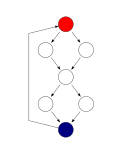In mathematical logic, the compactness theorem states that a set of first-order sentences has a model if and only if every finite subset of it has a model. This theorem is an important tool in model theory, as it provides a useful method for constructing models of any set of sentences that is finitely consistent.
In the context of hardware and software systems, formal verification is the act of proving or disproving the correctness of a system with respect to a certain formal specification or property, using formal methods of mathematics. Formal verification is a key incentive for formal specification of systems, and is at the core of formal methods. It represents an important dimension of analysis and verification in electronic design automation and is one approach to software verification. The use of formal verification enables the highest Evaluation Assurance Level (EAL7) in the framework of common criteria for computer security certification.
In logic, temporal logic is any system of rules and symbolism for representing, and reasoning about, propositions qualified in terms of time. It is sometimes also used to refer to tense logic, a modal logic-based system of temporal logic introduced by Arthur Prior in the late 1950s, with important contributions by Hans Kamp. It has been further developed by computer scientists, notably Amir Pnueli, and logicians.
In logic, linear temporal logic or linear-time temporal logic (LTL) is a modal temporal logic with modalities referring to time. In LTL, one can encode formulae about the future of paths, e.g., a condition will eventually be true, a condition will be true until another fact becomes true, etc. It is a fragment of the more complex CTL*, which additionally allows branching time and quantifiers. LTL is sometimes called propositional temporal logic, abbreviated PTL. In terms of expressive power, linear temporal logic (LTL) is a fragment of first-order logic.
Property Specification Language (PSL) is a temporal logic extending linear temporal logic with a range of operators for both ease of expression and enhancement of expressive power. PSL makes an extensive use of regular expressions and syntactic sugaring. It is widely used in the hardware design and verification industry, where formal verification tools and/or logic simulation tools are used to prove or refute that a given PSL formula holds on a given design.
Computation tree logic (CTL) is a branching-time logic, meaning that its model of time is a tree-like structure in which the future is not determined; there are different paths in the future, any one of which might be an actual path that is realized. It is used in formal verification of software or hardware artifacts, typically by software applications known as model checkers, which determine if a given artifact possesses safety or liveness properties. For example, CTL can specify that when some initial condition is satisfied, then all possible executions of a program avoid some undesirable condition. In this example, the safety property could be verified by a model checker that explores all possible transitions out of program states satisfying the initial condition and ensures that all such executions satisfy the property. Computation tree logic belongs to a class of temporal logics that includes linear temporal logic (LTL). Although there are properties expressible only in CTL and properties expressible only in LTL, all properties expressible in either logic can also be expressed in CTL*.

Model-based testing is an application of model-based design for designing and optionally also executing artifacts to perform software testing or system testing. Models can be used to represent the desired behavior of a system under test (SUT), or to represent testing strategies and a test environment. The picture on the right depicts the former approach.
Independence-friendly logic is an extension of classical first-order logic (FOL) by means of slashed quantifiers of the form and , where is a finite set of variables. The intended reading of is "there is a which is functionally independent from the variables in ". IF logic allows one to express more general patterns of dependence between variables than those which are implicit in first-order logic. This greater level of generality leads to an actual increase in expressive power; the set of IF sentences can characterize the same classes of structures as existential second-order logic.
Runtime verification is a computing system analysis and execution approach based on extracting information from a running system and using it to detect and possibly react to observed behaviors satisfying or violating certain properties. Some very particular properties, such as datarace and deadlock freedom, are typically desired to be satisfied by all systems and may be best implemented algorithmically. Other properties can be more conveniently captured as formal specifications. Runtime verification specifications are typically expressed in trace predicate formalisms, such as finite state machines, regular expressions, context-free patterns, linear temporal logics, etc., or extensions of these. This allows for a less ad-hoc approach than normal testing. However, any mechanism for monitoring an executing system is considered runtime verification, including verifying against test oracles and reference implementations. When formal requirements specifications are provided, monitors are synthesized from them and infused within the system by means of instrumentation. Runtime verification can be used for many purposes, such as security or safety policy monitoring, debugging, testing, verification, validation, profiling, fault protection, behavior modification, etc. Runtime verification avoids the complexity of traditional formal verification techniques, such as model checking and theorem proving, by analyzing only one or a few execution traces and by working directly with the actual system, thus scaling up relatively well and giving more confidence in the results of the analysis, at the expense of less coverage. Moreover, through its reflective capabilities runtime verification can be made an integral part of the target system, monitoring and guiding its execution during deployment.
In computer science and mathematical logic, satisfiability modulo theories (SMT) is the problem of determining whether a mathematical formula is satisfiable. It generalizes the Boolean satisfiability problem (SAT) to more complex formulas involving real numbers, integers, and/or various data structures such as lists, arrays, bit vectors, and strings. The name is derived from the fact that these expressions are interpreted within ("modulo") a certain formal theory in first-order logic with equality. SMT solvers are tools that aim to solve the SMT problem for a practical subset of inputs. SMT solvers such as Z3 and cvc5 have been used as a building block for a wide range of applications across computer science, including in automated theorem proving, program analysis, program verification, and software testing.
In theoretical computer science, the modal μ-calculus is an extension of propositional modal logic by adding the least fixed point operator μ and the greatest fixed point operator ν, thus a fixed-point logic.

Ernest Allen Emerson II, better known as E. Allen Emerson, is an American computer scientist and winner of the 2007 Turing Award. He is Professor and Regents Chair Emeritus at the University of Texas at Austin, United States.

CADP is a toolbox for the design of communication protocols and distributed systems. CADP is developed by the CONVECS team at INRIA Rhone-Alpes and connected to various complementary tools. CADP is maintained, regularly improved, and used in many industrial projects.

TLA+ is a formal specification language developed by Leslie Lamport. It is used for designing, modelling, documentation, and verification of programs, especially concurrent systems and distributed systems. TLA+ is considered to be exhaustively-testable pseudocode, and its use likened to drawing blueprints for software systems; TLA is an acronym for Temporal Logic of Actions.
In the mathematical fields of graph theory and finite model theory, the logic of graphs deals with formal specifications of graph properties using sentences of mathematical logic. There are several variations in the types of logical operation that can be used in these sentences. The first-order logic of graphs concerns sentences in which the variables and predicates concern individual vertices and edges of a graph, while monadic second-order graph logic allows quantification over sets of vertices or edges. Logics based on least fixed point operators allow more general predicates over tuples of vertices, but these predicates can only be constructed through fixed-point operators, restricting their power.
Metric temporal logic (MTL) is a special case of temporal logic. It is an extension of temporal logic in which temporal operators are replaced by time-constrained versions like until, next, since and previous operators. It is a linear-time logic that assumes both the interleaving and fictitious-clock abstractions. It is defined over a point-based weakly-monotonic integer-time semantics.
In model checking, the Metric Interval Temporal Logic (MITL) is a fragment of Metric Temporal Logic (MTL). This fragment is often preferred to MTL because some problems that are undecidable for MTL become decidable for MITL.
In model checking, a branch of computer science, linear time properties are used to describe requirements of a model of a computer system. Example properties include "the vending machine does not dispense a drink until money has been entered" or "the computer program eventually terminates". Fairness properties can be used to rule out unrealistic paths of a model. For instance, in a model of two traffic lights, the liveness property "both traffic lights are green infinitely often" may only be true under the unconditional fairness constraint "each traffic light changes colour infinitely often".
Counterexample-guided abstraction refinement (CEGAR) is a technique for symbolic model checking. It is also applied in modal logic tableau calculi algorithms to optimise their efficiency.

















